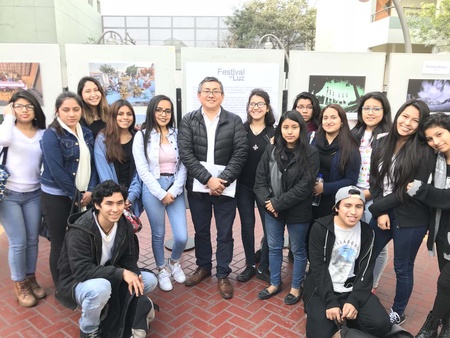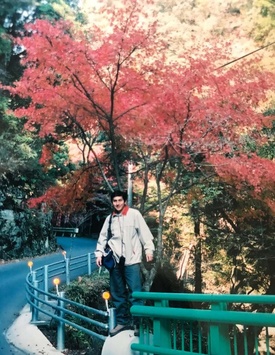In the life of the photographer and sociologist Óscar Chambi there seems to be no room for chance or isolated events. Everything seems interconnected and directed so that its various paths converge towards the same destination: the Nikkei community.
To trace the origins of this connection you have to go back to his childhood and travel to Cusco. His father, the filmmaker Martín Chambi, was his first bridge to the Nikkei. Óscar remembers that his father taught him to count in Japanese from one to ten. How did he learn? Through some Nisei friends named Kawamura. The relationship was so close that they became compadres.
Oscar's first contact with Japanese culture also came through his father. Already in Lima, thanks to him he saw Akira Kurosawa's films (on television or through a projector), of which he remembers three in particular: Rashomon , The Seven Samurai and Barbarossa . The first was the one that had the most impact on him due to the diversity of perspectives with which the story is told. That's where his admiration for Japanese culture was born.
Óscar remembers his father as a person who was very open to the diverse cultures that make up human history. He inherited that from him. In college, when he studied sociology, his interest focused on the Afro-Peruvian community. He traveled to Zaña, a town located in the north of Peru with a large Afro presence, and discovered a great ethnic diversity—blacks, Andeans, Chinese, Japanese—and a lot of miscegenation.
What migratory processes made this plurality and miscegenation possible? Where we come from? These questions prompted him to find out more about the cultural currents that make up Peru, especially the Japanese.
In Zaña he met a hairdresser named Hamada and an announcer, Miyakawa, who broadcast the news of the town. How did the Hamada and Miyakawa get from the other side of the ocean to Peru? And once in the country, how did they settle in a town so far from the capital and the main port of Peru?
Thanks to his work with the Afro community, Óscar met the sociologist Luis Rocca, a specialist and author of several works on the subject who was key in his approach to the Nikkei community. Through him he reached Alejandro and Enrique Tamashiro, beloved Nisei brothers who published the legendary Puente magazine, a valuable journalistic effort to study Japanese immigration to Peru and understand the reality and identity of the Nisei.
The Tamashiro were his friends and teachers in every sense of the word. With them he learned a lot about Japanese immigration and from how to use hashi to the fundamentals of the Bushido code. They were also an example with their life, their sobriety, their nobility.
Luis Rocca is the author of the book Japanese under the sun of Lambayeque , a work about Japanese immigrants who put down roots in northern Peru and their descendants. Óscar collaborated with him by taking photos and collecting testimonies from Nikkei families. From that experience he remembers a family that kept a dagger from the father, who kept it in case he ever had to commit seppuku .
CULTURAL LEARNING
“You don't set out for affection,” says Óscar, referring to the unpredictable paths that brought him together with Angie, a Sansei designer. They married and had a son, Akira.
Through her he got to know traditional Nikkei families more deeply. His ancestors, on the maternal side, were Okinawans who settled on the San Agustín hacienda, the destination of many Japanese immigrants.
“I started learning words in Okinawan, its cultural manifestations: music, dance, food. For me that was very enriching for the soul and also for cultural learning,” he remembers.
In parallel with the development of emotional ties (his family, his friendship with the Tamashiro brothers), Óscar continued to strengthen his academic and work relationship with the community. He met the researcher Amelia Morimoto and thanks to her he had the opportunity to participate—as one of the authors—in the preparation of a book for the centenary of Japanese immigration to Peru, The Memory of the Eye , in 1999.
At that time, he taught at a graphic design institute. In a history of photography course, he asked his students to bring old photos of their families as a way to rescue and preserve family history through images.
One of his students, a young man of Italian descent, brought an album preserved in magnificent conditions that narrated, through photos, the history of the family from the Italian grandparents who migrated to Peru to the Peruvian grandchildren. Óscar was impressed: through a family album he managed to grasp the history of Italian migration to Peru.
Why not do something similar with the centenary book: tell the story of Japanese immigration to Peru through photographs of many Nikkei families?
Óscar proposed the idea to Amelia Morimoto, the creator of the project, and she liked it. The poet José Watanabe joined them both. As part of their work, they traveled through Peru to collect graphic and oral testimonies.
From that enriching experience, she remembers the lesson she learned from the story of an Issei woman who was married by photography and who upon arriving in Peru became disillusioned with her husband because the real man looked pale next to the man in the photo. However, her husband was a respectful and good person who little by little won her heart. From her own experience, the Issei said that Western love was like a pot of boiling water that little by little became cold, and Eastern love was like a pot of cold water that little by little became hot.
JAPAN, A PRIZE
In 2001, Óscar Chambi traveled to Japan. He worked as a dekasegi for almost two years. It was his first trip to Japan, the great opportunity to learn and see in situ how similar the real country was to the one he had formed in his head from studies, testimonies and films. “I loved Japanese culture, so for me it was a reward to go to Japan,” he says. And if cultural learning was complemented with economic income, the better.
Óscar describes his dekasegi experience as “very good.” It fell in the right place: the port of Yaizu, located in the prefecture of Shizuoka, a place where modern constructions and the countryside harmonized, “a super-organized coexistence” between the rural and the urban, a building next to a rice field. Nothing to do with “the ostentation of a great neon metropolis.” Perhaps your assessment today would be different if you had lived in a megacity like Tokyo.
His workplace was a fish factory. At the same time, thanks to the help of a friend, the Japanese journalist Hirohito Ota (former Japanese editor-in-chief of Peru Shimpo), took photos for various publications in Japan.
Ota – who acted as cupid because thanks to him he met his current wife Chikako, a Japanese journalist – did a report on him for a Japanese magazine presenting him as a Peruvian dekasegi who was also a photographer and sociologist. The note opened several doors for him in Japan.
Taking photos in Japan and having them published and paid for them was like a dream come true for him; Furthermore, in Japan, “the paradise of photography”, where photographers are very well regarded.
The lessons of his teachers, the Tamashiro, helped him build bridges with the Japanese. The Nisei brothers taught him, for example, that rice is never left alone and he did so in Japan: his veteran co-workers in the factory appreciated that gesture of respect for food that sometimes even the young Japanese themselves overlooked.
NIKKEI EVOLUTION: FROM THE BUBBLE TO THE GLOBAL VISION
Óscar Chambi does not hesitate to name what for him has been the most important change that the Nikkei community has experienced in the last 30 years: “What stands out the most is the miscegenation. The Nikkei are beginning to open up more, the sansei or yonsei have a different outlook, I think they are more cosmopolitan, more international, more global. The third or fourth generation is thinking about the US, Europe, both in business and in studies.”
In the past, there were Nikkei who “lived like they were in Japan in Peru”: their circle was restricted to the community. “That almost doesn't exist anymore, in the 1980s and 1990s those bubbles were much stronger,” he adds. In his opinion, miscegenation has influenced the openness.
The memory of the eye , the book of the centenary of Japanese immigration to Peru, closed with photos of Nikkei children, many of them mestizo, envisioning a 21st century of greater ethnic fusion.
One of those children was his son Akira, today a young Yonsei university student. How has your Nikkei identity evolved?
“As a child, as happens to everyone, they stigmatize you, they call you 'Chinese' and you don't want to be one. Or you go to Bembos 1 , Kentucky 2 , whatever, they tell you 'what's your name', you tell them 'Akira' and they don't understand you at all; They call you 'Shakira', whatever. Obviously it shocks you and then you say 'my name is Alejandro', you don't want to be called Akira. Maybe these shocks he had as a child made him look at (his Japanese origins) with reservations,” he says.
“Then he started to assimilate it. In addition, there is good acceptance of Nikkei in the country. In some way he also lives that and is aware of it. As a teenager, he became more interested in his origins, in the Nikkei culture, he began to study, to learn about his great-grandparents, how they came," he details.
Recognizing yourself as part of a culture does not mean locking yourself into it. On the contrary, it is an opportunity to broaden your horizons and open up more to the world. This is the case of Akira.
“Like many Nikkei, he is already a universal Peruvian, he speaks perfect English, he is connected to the world. The Nikkei is a good reference, an identity that is well marked, as much as the Andean part, but it is a citizen of the world, it goes down that path in which many young Nikkei come together."
Grades:
1. Fast food chain
2.KFC
© 2019 Enrique Higa Sakuda








